Alacahöyük
ANCIENT CITIES
Alacahöyük
Alacahöyük is located 45 kilometres south of Çorum and 17 kilometres northwest of the Alaca township. The Alacahöyük village is 34 kilometres away from Boğazköy and 210 kilometres away from Ankara.
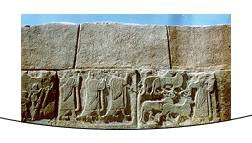
This tumulus, or mound, was first introduced to the world of science by W.C. Hamilton in 1835 and after that time, it became a place frequented by scientists who visited Central Anatolia. In 1861, G. Perrot stopped by this tumulus and discovered the plan of the square tower on the left and right of the door and one of the orthostats. After this study, Perrot became the first to argue that these reliefs belonged to the Hittite period.
The ritual symbol
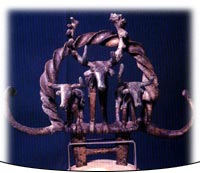 W. Ramsey, who made great contributions to Anatolia’s historical geography, studied the tumulus together with Wilson in 1881 and found a few other reliefs. In 1893, E. Chantre came to the tumulus and found the square corridors among the sphinx, the second door at the end and the door frames. Chantre took the plaster casts of these reliefs and by judging from their themes, Chantre claimed that this could be the door of a temple rather than a palace. Chantre studied the lions on the south of the door with the sphinx and believed that the inscription found on one of these doors was Phrygian writing. Later H. Winckler, who had been working in Boğazköy since 1906, decided to start a search in the tumulus at the invitation of Makridi Bey and İstanbul Archaeology Museum Director Halil Ethem Bey. In 1907, Makridi Bey worked for 15 days at the door with the sphinx and discovered a few new orthostats in front of the door. After drilling a few places in the tumulus, he saw the poterni (entrance) on the northern edge of the tumulus and he compared this to the potern in Boğazköy. The first systematic excavations of the tumulus were started by Atatürk in the Republican era. Hamit Zübeyr Koşay, Remzi Oğuz Arik and Mahmut Akok from the Turkish History Institution began excavations in 1935 which lasted until 1983. The excavations were interrupted this year and in 1997, they were started again by Professor Aykut Çınaroğlu.
W. Ramsey, who made great contributions to Anatolia’s historical geography, studied the tumulus together with Wilson in 1881 and found a few other reliefs. In 1893, E. Chantre came to the tumulus and found the square corridors among the sphinx, the second door at the end and the door frames. Chantre took the plaster casts of these reliefs and by judging from their themes, Chantre claimed that this could be the door of a temple rather than a palace. Chantre studied the lions on the south of the door with the sphinx and believed that the inscription found on one of these doors was Phrygian writing. Later H. Winckler, who had been working in Boğazköy since 1906, decided to start a search in the tumulus at the invitation of Makridi Bey and İstanbul Archaeology Museum Director Halil Ethem Bey. In 1907, Makridi Bey worked for 15 days at the door with the sphinx and discovered a few new orthostats in front of the door. After drilling a few places in the tumulus, he saw the poterni (entrance) on the northern edge of the tumulus and he compared this to the potern in Boğazköy. The first systematic excavations of the tumulus were started by Atatürk in the Republican era. Hamit Zübeyr Koşay, Remzi Oğuz Arik and Mahmut Akok from the Turkish History Institution began excavations in 1935 which lasted until 1983. The excavations were interrupted this year and in 1997, they were started again by Professor Aykut Çınaroğlu.
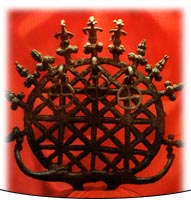
Studies and excavations tell us that there were four layers of cultures that existed in Alacahöyük, which was inhabited continuously since the Chalcolithic (copper) Age. These four layers are the Chalcolithic, Old Bronze, Hittite and Phrygian ages, and each of them has 15 different architectural layers.
The Chalcolithic Age: 4000-3000 B.C., layers 15-9
Old Bronze Age: 3000-2000, layers 8-5
Hittite Age: 1800-1200, layers 4-2
Phrygian Age: Since 750 B.C. in the first layer
The first settlement in the tumulus set up in the Chalcolithic Age was established on an area looking to the south, above sea level, and its northern parts were protected with small hills. In this age, architecture only meant stone foundations and sun-dried bricks. The roofs were covered with reeds and compressed soil.
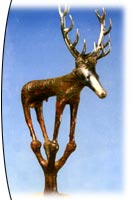
There were 13 important kings’ tombs in Alacahöyük in the Old Bronze Age, which was followed by the Chalcolithic Age and which was represented by four layers. The tombs which are believed to belong to layers five and seven are located in a special area of the city. Because of their forms, these are considered to be unique tombs of Anatolia and even the Asian frontier. These tombs belong to adult men and women. No children or babies were buried here. In contrast to the tomb types in Central Anatolia, in Alacahöyük there is uniformity in the direction of the tombs and the buried people. The gifts buried along with the dead are the richest and most varied that are found in the Aegean and the Asia frontier in the Old Bronze Age. Among these gifts are sun disks, deer and bull sculptures, decorative pieces, fighting tools such as daggers, swords and axes, and other pieces made out of cooked clay, stones, gold, silver, bronze, and copper. The architectural system of Alacahöyük in the Old Bronze Age depended on the authentic building technique of Anatolia. Buildings constructed using this technique has stone foundations, sun-dried bricks, flat ceilings, plastered floor and earth roofs. The Hittite layers that form the visible part of Alacahöyük are formed by three layers. In this age, a defence system was formed in the form of a circle with a diametre of 250 metres, and on this circle two main gates that were the entrances to the city are found. One of these entrances was the eastern door with a sphinx and the door on the western side of the tumulus.
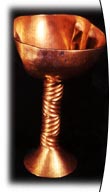
There are two sphinxes on the south-eastern door, which was the religious door of the tumulus. The heads are remarkable on the sphinx protoms that are carved on monolithic stone lentos. Sphinxes with inflated bodies stay on top of separated short legs. There is also a double-headed eagle carrying a rabbit in his claws in the interior side of the sphinx on the east.
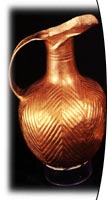 The reliefs under the towers on east and western side of the door with sphinxes are done using low relief technique and the details were given using plastic techniques. Almost all of the orthostats in the western tower are seen as a single frieze. On the lower part, there are pictures on the theme of cult-libation and on the upper part; there are depictions of hunt scenes. The head priest, the king and the queen were depicted as praying in front of a bull during a holiday ceremony which was celebrated to honour the storm god and which was mentioned in Hittite religious texts. Other reliefs depicted other phases of the ceremony. There are pictures of people praying in front of a goddess in the reliefs in the eastern tower, and these show that cult ceremonies were continuing in this age.
The reliefs under the towers on east and western side of the door with sphinxes are done using low relief technique and the details were given using plastic techniques. Almost all of the orthostats in the western tower are seen as a single frieze. On the lower part, there are pictures on the theme of cult-libation and on the upper part; there are depictions of hunt scenes. The head priest, the king and the queen were depicted as praying in front of a bull during a holiday ceremony which was celebrated to honour the storm god and which was mentioned in Hittite religious texts. Other reliefs depicted other phases of the ceremony. There are pictures of people praying in front of a goddess in the reliefs in the eastern tower, and these show that cult ceremonies were continuing in this age.
After entering from the door with the sphinx and passing the entrance complex, on the right you can see the foundation of a large Hittite building which was called Mabet-Saray (Temple-Palace). This building is formed by various storage rooms and other complexes.